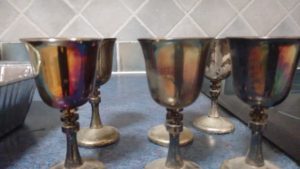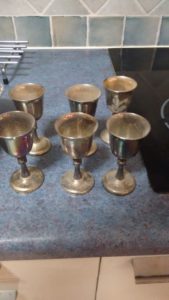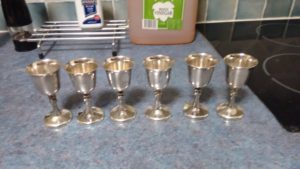When I was recently cleaning out my house I came across half a dozen old silver goblets and my first thought was “These would be perfect Fretted Goblets” (note: The Fretted Goblet is the Innilgard Baronial Service award, they look pretty and you can put alcohol in them).
Being me, I put them aside and didn’t pick them up until a few weeks ago, doing a second clean of my house. I ended up doing a bunch of research on how to clean them, given their age, my uncertainty over their makeup being silver or silver plate, and my desire to not spend much money. I came across a cheap, easy method that makes cleaning addictive.
These Goblets had been sitting in a dark cupboard for over 20 years. I’d imagine they may well be older than me, or possibly even the Barony itself. That said, other than the tarnish/grime and discoloration there was no overt damage. While my method of cleaning has worked on Goblets after I’ve engraved them, I’m not sure of the results if you had major chips/damage to silver plate.
As you can see, they were really filthy, I know in the past I’ve actually thrown out pieces of cheap silver plate that were this dirty on the basis that it would probably take too much work to restore. The whole reason I began this project with these was I considered them expendable, but they turned out better than I hoped.
Step 1. Using either aluminum foil trays, or a plastic/glass/non metal container lined with aluminum foil, add in a small handful of sea salt, boiling water, a few tablespoons of baking soda (enough to get the water bubbly) – then lay your pieces of silver in the mixture taking care not to be burnt. It doesn’t have to fully submerge the item, as you will probably make multiple passes and rotate the item, but the silver items MUST touch the aluminum foil and MUST NOT touch each other. Finally, pour in some white vinegar until the mixture begins a happy little bubble.
Sit back, wait, get a glass of wine. After an hour or two, or when the water has gone cold, take your items out, and using a paper towel, gently wipe them clean. You’ll noticeably turn a white paper towel black, although you may need to repeat this process a few time.
It is worthwhile to regularly replace your aluminum foil every pass or two, as it increases the efficiency. Pictured above you can see visible discoloration left from using the same tray for multiple passes.
So, after only a few passes in their cleaning baths, no harsh or expensive chemicals, you have goblets approx 95% cleaner than they were. They are not *perfectly* cleaned, imperfections and stubborn spots still exist, however I like to think of them as charms of character rather than imperfections.
This ends the silver cleaning portion, the following details turning the cleaned item into Baronial Awards.
The award itself is a simple silver Goblet with a red frette engraved and painted into the side. How hard could it be?
Using a cheap engraving pen I had laying around from a discount hardware store, I carefully engraved frettes into the goblets, just enough to create a tactile sensation when running a finger over it. This is one of the prettier results. I ended up supporting it with my hands, it would have been much easier with a small vise to support the item.
Visiting my local train hobby store, I was able to find a small pot of red enamel for under $4 that would probably allow me to make a few dozen goblets with ease.
I experimented with multiple ways of applying the enamel. I didn’t have any very tiny brushes so I made do with a combination of toothpicks, cotton swabs, methylated spirits and of course, the enamel.
I covered my table in a moderate amount of paper towels and stirred the enamel to make sure it was consistant in texture. Using a toothpick I gently spread and encouraged it into the engraved frettes. There was inevitable spillage.
As you can see, the initial result looked more like a blob of paint. I then was able to sharpen the enamel after it had partially set involving some painstaking fine detail work.
Using a cotton swab, I first dabbed a small amount of methylated spirits around the paint, not touching, being careful to only work on half at a time to prevent the spirits from rolling into the paint fully. Using a toothpick whose tip I had soaked in spirits, I then carefully and gently scraped at the paint, lifting off the excess and creating clarity in the design. This took a few passes and more than one toothpick.
I found that while it was easier to lift the enamel straight away after painting, it was also easier to accidentally damage the frette, requiring repainting. So, I found myself waiting around 2 hours before sitting down and going to work in earnest.
As you can see, there is clearly a frette now rather than a blob of paint. All that was left was to finish up the others, and add colored ties to allow the new Fretted Goblets to be attached to belts for easy transport and display.
I presented them today at the Barons Championship tournament to the B&B, including giving the prettiest one to Baroness Aeschine, as she had given me hers when she presented me with mine earlier this year.
Overall, this was a fun project, first time engraving, first time painting anything that small for almost 20 years and a new cleaning technique that has me hunting OP shops for old (cheap) silver plate I can look at restoring.











